Bye-Bye RAF C130K
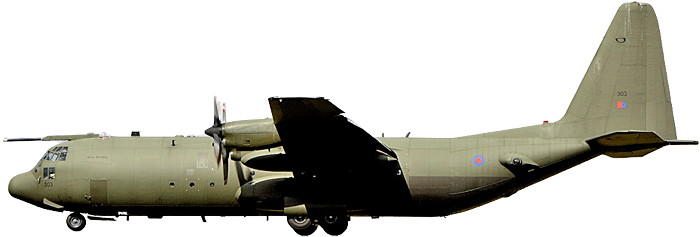
A Royal Air Force decision to take the seven remaining C-130Ks out of service brings to a close a 45-year operational association of the variant with the RAF.
The Royal Air Force will axe the final C-130K special forces Hercules from its fleet of airlifters by the end of this month. The Defence Ministry is cannibalizing the Lockheed Martin-built aircraft of its defensive aids suite to fit into some of the C-130J models being equipped to fill the role according to the MoD.
The decision leaves Britain’s tactical airlift dependent on 25 of the more modern J models ahead of the introduction of the Airbus A400M next year.
The move has been prompted in part by the heavy cost of keeping the aircraft airworthy. One MoD source said keeping them flying would not have made economic sense, and with the K effectively at the end of its service life, it made more sense to invest in further J capabilities.
It’s the second aging air asset the British have stood down recently. Late last month, the Air Force finally took its VC10 air transport/air tanker fleet out of operation after 47 years of service.
The British C-130K fleet has been gradually run down over the past few years. The aircraft has had its out-of-service date extended several times, mainly as a result of serious delays to the A400M program and to a lesser degree the failure to complete the Block 7 upgrade to the J fleet on time.
Deliveries to lead customer France have commenced on the Airbus aircraft, which in payload sits between the Hercules and the Boeing C-17, which the Royal Air Force also operates.
Increasing numbers of Airbus A330 tanker/transports now coming into service, a handful of old Lockheed Tristars and some leased BAE 146 jets make up the remainder of the British airlift fleet.
Doug Barrie, the senior air analyst at the International Institute of Strategic Studies in London, said the timing of the out-of-service decision might stretch resources as Britain completes the drawdown of combat troops from Afghanistan next year.
“It’s hardly ideal to lose airlift capability at this point with the VC10s only recently going out of service, the AirTanker program not up to full speed and with only limited numbers of Tristars available. Of course we don’t know what the level of special forces activity is right now but the Ks will have to be replaced with other airlift assets,” he said.
Defense News
The decision leaves Britain’s tactical airlift dependent on 25 of the more modern J models ahead of the introduction of the Airbus A400M next year.
The move has been prompted in part by the heavy cost of keeping the aircraft airworthy. One MoD source said keeping them flying would not have made economic sense, and with the K effectively at the end of its service life, it made more sense to invest in further J capabilities.
It’s the second aging air asset the British have stood down recently. Late last month, the Air Force finally took its VC10 air transport/air tanker fleet out of operation after 47 years of service.
The British C-130K fleet has been gradually run down over the past few years. The aircraft has had its out-of-service date extended several times, mainly as a result of serious delays to the A400M program and to a lesser degree the failure to complete the Block 7 upgrade to the J fleet on time.
Deliveries to lead customer France have commenced on the Airbus aircraft, which in payload sits between the Hercules and the Boeing C-17, which the Royal Air Force also operates.
Increasing numbers of Airbus A330 tanker/transports now coming into service, a handful of old Lockheed Tristars and some leased BAE 146 jets make up the remainder of the British airlift fleet.
Doug Barrie, the senior air analyst at the International Institute of Strategic Studies in London, said the timing of the out-of-service decision might stretch resources as Britain completes the drawdown of combat troops from Afghanistan next year.
“It’s hardly ideal to lose airlift capability at this point with the VC10s only recently going out of service, the AirTanker program not up to full speed and with only limited numbers of Tristars available. Of course we don’t know what the level of special forces activity is right now but the Ks will have to be replaced with other airlift assets,” he said.
Defense News
From: Sam Mold, Brighton & Hove
Sent: Friday, September 27, 2013 12:22 AM
Subject: UKMAMSOBA Members
Hi Tony,
In two of your recent newsletters I see that Bill Girdwood gets a mention. I would not expect him to remember me, but I met a F/Off of that name in the late Fifties who was attending No 31 Senior Movements Course at RAF Kidbrooke. Our six week course was from 7th Jan to 19th Feb, 1959. If he is that same officer he must now be in his 70’s. We also had two Royal Iranian Air Force officers on the same course.
The number of Movers who are still around from the Fifties is getting smaller and smaller, and because we are a dying breed a great number of them must have gone off to join PAFITS (Permanent Air Force in the Sky). So I was very pleased when one of your regular correspondents, Jack Riley, responded to the article I wrote about Butterworth. Checking your website, I see that Jack was serving at HQ FEAF in 1949, beating me to Singapore by two years. Having served more than four years in UK, I eventually reached that tropical paradise when my four-week cruise ended and I stepped off the troopship, HMT “Dunera” as a 21 year old innocent abroad.
In those innocent days of sweet youth I had been posted to 390 MU, Seletar, never imaging that before my 2½ year tour was over another three postings were awaiting me: No 91 Sqdn (a mobile RAF Regt [Malaya] unit), Tengah (Equipment Section) and Butterworth (Air Movements). Nor could I have imagined that over the next two decades there would be three more tours east of India: Australia (Maralinga and Edinburgh Field), Malaysia (RMAF Kuala Lumpur) and a final return to Singapore (Tengah - 20 years on from my first arrival). A lot of RAF friends I know find it hard to believe that I enjoyed my 2 year tour in Aden, more so than my time in Australia; but nonetheless, Singapore/Malaysia still come out top of the popularity polls.
Something I share with Jack is that we both have two GSM’s (Malaya and Malaysia). I take it that his Malaysia gong is for the Indonesian “Confrontation” period, and I’m wondering if he ever claimed the PJM (Pingat Jasa Malaysia) medal) for those who served there? From the medals I see on your website photo of him I can’t see the PJM displayed. To wear the PJM alongside British gongs has been permitted since 11th Nov, 2011. Trusting that all your readers are aware of the Malaysian award.
Happy newletter publishing and best wishes, Sam.
Sent: Friday, September 27, 2013 12:22 AM
Subject: UKMAMSOBA Members
Hi Tony,
In two of your recent newsletters I see that Bill Girdwood gets a mention. I would not expect him to remember me, but I met a F/Off of that name in the late Fifties who was attending No 31 Senior Movements Course at RAF Kidbrooke. Our six week course was from 7th Jan to 19th Feb, 1959. If he is that same officer he must now be in his 70’s. We also had two Royal Iranian Air Force officers on the same course.
The number of Movers who are still around from the Fifties is getting smaller and smaller, and because we are a dying breed a great number of them must have gone off to join PAFITS (Permanent Air Force in the Sky). So I was very pleased when one of your regular correspondents, Jack Riley, responded to the article I wrote about Butterworth. Checking your website, I see that Jack was serving at HQ FEAF in 1949, beating me to Singapore by two years. Having served more than four years in UK, I eventually reached that tropical paradise when my four-week cruise ended and I stepped off the troopship, HMT “Dunera” as a 21 year old innocent abroad.
In those innocent days of sweet youth I had been posted to 390 MU, Seletar, never imaging that before my 2½ year tour was over another three postings were awaiting me: No 91 Sqdn (a mobile RAF Regt [Malaya] unit), Tengah (Equipment Section) and Butterworth (Air Movements). Nor could I have imagined that over the next two decades there would be three more tours east of India: Australia (Maralinga and Edinburgh Field), Malaysia (RMAF Kuala Lumpur) and a final return to Singapore (Tengah - 20 years on from my first arrival). A lot of RAF friends I know find it hard to believe that I enjoyed my 2 year tour in Aden, more so than my time in Australia; but nonetheless, Singapore/Malaysia still come out top of the popularity polls.
Something I share with Jack is that we both have two GSM’s (Malaya and Malaysia). I take it that his Malaysia gong is for the Indonesian “Confrontation” period, and I’m wondering if he ever claimed the PJM (Pingat Jasa Malaysia) medal) for those who served there? From the medals I see on your website photo of him I can’t see the PJM displayed. To wear the PJM alongside British gongs has been permitted since 11th Nov, 2011. Trusting that all your readers are aware of the Malaysian award.
Happy newletter publishing and best wishes, Sam.

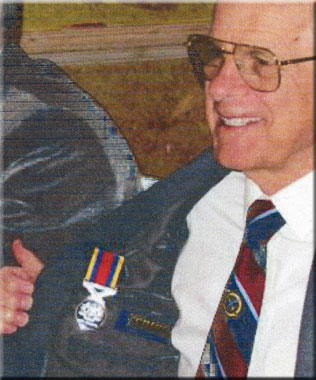
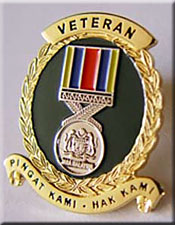
Lapel Pin
Showing off my Malaysian medal
From: Jeremy Allen, Cheltenham
Sent: Friday, October 04, 2013 8:30 PM
Subject: Return to Calgary
Hi Tony,
Sent: Friday, October 04, 2013 8:30 PM
Subject: Return to Calgary
Hi Tony,
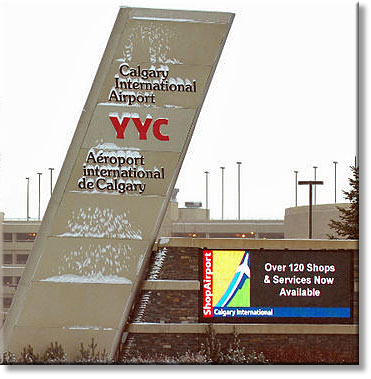
I thought the readers might find this interesting or nostalgic.
YYC was always a favourite destination of mine on MAMS. There was just something about the place. A high- rise downtown that really was just a disguise for the cowboy town that Calgary really was.
Like many other teams in the 80s, Kilo found itself a regular visitor, generally in support of "Trumpet Dance" or the routine missions for BATUS; Calgary was an extension to the crew room at Lyneham.
Until now, I haven't been back to Calgary since my last trip in 1984. Ian Russel was the RAFRLO in those days complete with enormous white Chevvy Impala station wagon. One of my trips was on my own as I was standing in for Ian for 3 weeks while he went back to the UK. I recall that Kim came to join me for the last 2 weeks on one of the first Tristar 500 flights in RAF colours to arrive in YYC.
For those spotters among you the flights in those days still used BA crews and had no markings except for the RAF flash on the tail. She was one of only about 5 passengers on the flight including Mark Attrill (remember that Mark?).
YYC was always a favourite destination of mine on MAMS. There was just something about the place. A high- rise downtown that really was just a disguise for the cowboy town that Calgary really was.
Like many other teams in the 80s, Kilo found itself a regular visitor, generally in support of "Trumpet Dance" or the routine missions for BATUS; Calgary was an extension to the crew room at Lyneham.
Until now, I haven't been back to Calgary since my last trip in 1984. Ian Russel was the RAFRLO in those days complete with enormous white Chevvy Impala station wagon. One of my trips was on my own as I was standing in for Ian for 3 weeks while he went back to the UK. I recall that Kim came to join me for the last 2 weeks on one of the first Tristar 500 flights in RAF colours to arrive in YYC.
For those spotters among you the flights in those days still used BA crews and had no markings except for the RAF flash on the tail. She was one of only about 5 passengers on the flight including Mark Attrill (remember that Mark?).
So 29 years later I am sitting in the BA lounge at YYC waiting for my flight back to LHR. What did I find? Except for the obvious 'digitisation' of the city, there is nothing that stands out as 'wow, hasn't that changed'. It is still a stunning location nestled in the flats before the steep rise into the snow capped Rockies - very well covered with snow, even on 3 October.
The airport is only just building a second terminal. It will be for international flights. It's not that the number of international flights has increased, it's more the growth of the internal market (particularly WestJet) that is pushing the others out of the cramped original terminal.
On a quick airside drive, I tried to spot the Air Canada traffic office that we used to despatch the RAF flights from but my memory just isn't that good.
I was very tempted to do the whole nostalgia thing and stay in the Delta Bow Valley Hotel but ended up in a small boutique place opposite the famous (or infamous) Palliser. If I recall, Ian had set up the new RAF contract with the brand new Delta Bow Valley and in the 80s I loved it! Some of my hairier colleagues and many aircrew pined to return to The Palliser. Maybe it was the hotel manager wandering around with free scotch or it's reputation as a place for night 'crawlers' I never understood. To me it was a creaky joint, noisy at the back because of the 100-carriage trains that used to roll by for hours early in the morning and was well past it's former glory. Well, The Palliser is now a Fairmont and a very swanky joint indeed with prices to match.
For John McClymont and Hammy, the No 1 Canadian Legion is also still going strong. John, never known for the liberal spending of his allowances, used to drag me into this drinking den of long tables full of retirees in blazers and badges playing bingo.
One of my fond memories of Calgary was Mother Tucker's, a fantastic buffet and prime rib restaurant that nearly all MAMS teams used to use. I am afraid that MT is no more. It's place has been taken by a giant Starbucks... now that really is something that didn't exist in the 80s.
I am afraid on this trip that there was no time for the drive to Banff and Lake Louise. I have resolved however that Kim and I will come back next year on holiday. How quickly we forget how wonderful some of these locations really are and also how much we perhaps took them for granted.
Finally, I had a text from Kim reminding me of some music we had bought on our trip. She said I had bought a CD... quickly I reminded her that it was a cassette tape, CDs were years away yet. Funny how both are now yesterday's technology. God, I'm getting old but not as old as you Bruce.
Best to all
Jerry Allen
The airport is only just building a second terminal. It will be for international flights. It's not that the number of international flights has increased, it's more the growth of the internal market (particularly WestJet) that is pushing the others out of the cramped original terminal.
On a quick airside drive, I tried to spot the Air Canada traffic office that we used to despatch the RAF flights from but my memory just isn't that good.
I was very tempted to do the whole nostalgia thing and stay in the Delta Bow Valley Hotel but ended up in a small boutique place opposite the famous (or infamous) Palliser. If I recall, Ian had set up the new RAF contract with the brand new Delta Bow Valley and in the 80s I loved it! Some of my hairier colleagues and many aircrew pined to return to The Palliser. Maybe it was the hotel manager wandering around with free scotch or it's reputation as a place for night 'crawlers' I never understood. To me it was a creaky joint, noisy at the back because of the 100-carriage trains that used to roll by for hours early in the morning and was well past it's former glory. Well, The Palliser is now a Fairmont and a very swanky joint indeed with prices to match.
For John McClymont and Hammy, the No 1 Canadian Legion is also still going strong. John, never known for the liberal spending of his allowances, used to drag me into this drinking den of long tables full of retirees in blazers and badges playing bingo.
One of my fond memories of Calgary was Mother Tucker's, a fantastic buffet and prime rib restaurant that nearly all MAMS teams used to use. I am afraid that MT is no more. It's place has been taken by a giant Starbucks... now that really is something that didn't exist in the 80s.
I am afraid on this trip that there was no time for the drive to Banff and Lake Louise. I have resolved however that Kim and I will come back next year on holiday. How quickly we forget how wonderful some of these locations really are and also how much we perhaps took them for granted.
Finally, I had a text from Kim reminding me of some music we had bought on our trip. She said I had bought a CD... quickly I reminded her that it was a cassette tape, CDs were years away yet. Funny how both are now yesterday's technology. God, I'm getting old but not as old as you Bruce.
Best to all
Jerry Allen
From: Steve Richardson, Trenton, ON
Sent: Thursday, September 26, 2013 10:14 PM
Subject: RCAF Mystery Photo 092713
Tony,
The photo has Prince Charles on the left presenting Captain Claude Caron with the Queen's Diamond Jubilee medal. Capt Claude Caron has since retired from the RCAF after serving 41 years.
He had a very distinguished career in Air Movements and as a Loadmaster on various aircraft within the RCAF.
Also, he and I ran into each other at various locations over the years. I wish him good luck and best wishes for his future endeavours.
Take care,
Steve Richardson
Sent: Thursday, September 26, 2013 10:14 PM
Subject: RCAF Mystery Photo 092713
Tony,
The photo has Prince Charles on the left presenting Captain Claude Caron with the Queen's Diamond Jubilee medal. Capt Claude Caron has since retired from the RCAF after serving 41 years.
He had a very distinguished career in Air Movements and as a Loadmaster on various aircraft within the RCAF.
Also, he and I ran into each other at various locations over the years. I wish him good luck and best wishes for his future endeavours.
Take care,
Steve Richardson
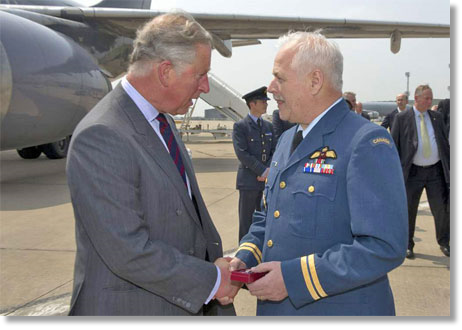
From: Woody Wood, Pembroke, ON
Sent: Saturday, September 28, 2013 3:33 PM
Subject: RE: UKMAMS OBA OBB #092713
Hi Trapper;
The RCAF Mystery Photo 092713:
His Royal Highness, Prince Charles presenting Capt (formerly CWO Traffic Tech) Claude Caron with the Queen's Jubilee Medal...
Claude is a great Mover who recently retired in Ottawa.
Take care
Woody
Sent: Saturday, September 28, 2013 3:33 PM
Subject: RE: UKMAMS OBA OBB #092713
Hi Trapper;
The RCAF Mystery Photo 092713:
His Royal Highness, Prince Charles presenting Capt (formerly CWO Traffic Tech) Claude Caron with the Queen's Jubilee Medal...
Claude is a great Mover who recently retired in Ottawa.
Take care
Woody
From: Jimmie Durkin, Stafford
Sent: Wednesday, October 02, 2013 6:10 AM
Subject: Abingdon
Hello again Tony,
Thank you once again for yet another great edition. I was thinking about MAMS at Abingdon and could not recall any mention of a squadron or teams during my time at the base.
My memory may not be spot on but basically AMS Abingdon was mainly located in 'A' hangar for freight with the pax section located on the opposite side of the airfield to the hangar. After some 'on the job' training' from Sgt Pete Smith I was given charge of Cargo Control where I remained, apart from absence on courses, for about 2 years. I believe I was posted in from Khormaksar, Aden during May or June 1957,
In the latter part of my tour, Sgt John Guerin and me were told we were were to become attached to TCAMDU (we all pronounced it as tackamdoo) and would become mobile. Later due to finance the plot was reduced to one Sgt and John spent a long time airborne, flying all over place and also having regular short detachments to Nice and Orange (South of France). I carried on working in Cargo Control.
Sent: Wednesday, October 02, 2013 6:10 AM
Subject: Abingdon
Hello again Tony,
Thank you once again for yet another great edition. I was thinking about MAMS at Abingdon and could not recall any mention of a squadron or teams during my time at the base.
My memory may not be spot on but basically AMS Abingdon was mainly located in 'A' hangar for freight with the pax section located on the opposite side of the airfield to the hangar. After some 'on the job' training' from Sgt Pete Smith I was given charge of Cargo Control where I remained, apart from absence on courses, for about 2 years. I believe I was posted in from Khormaksar, Aden during May or June 1957,
In the latter part of my tour, Sgt John Guerin and me were told we were were to become attached to TCAMDU (we all pronounced it as tackamdoo) and would become mobile. Later due to finance the plot was reduced to one Sgt and John spent a long time airborne, flying all over place and also having regular short detachments to Nice and Orange (South of France). I carried on working in Cargo Control.
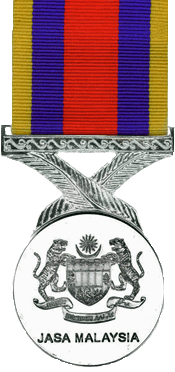
The chippies built a wooden mock-up of the Britannia freight loading area in A hangar (at its working height) and I remember people using it I believe were TCAMDU staff for practice and training. I can't recall ever having to load a Brit at that time at Abingdon.
I was posted to HQRAFG for CMOVO staff and later as Mov Ops 2(a) during December 1959; John followed me to Germany and was based at RAF Sylt. I was repatriated in June 1962 and John replaced me.
I certainly cannot recall one MAMS Team at Abingdon and surely would remember four if any or all existed? They certainly were not based in A hangar but possibly came in from a unit near Didcot (can't remember its name) for training on the Brit mock-up.
I was posted to HQRAFG for CMOVO staff and later as Mov Ops 2(a) during December 1959; John followed me to Germany and was based at RAF Sylt. I was repatriated in June 1962 and John replaced me.
I certainly cannot recall one MAMS Team at Abingdon and surely would remember four if any or all existed? They certainly were not based in A hangar but possibly came in from a unit near Didcot (can't remember its name) for training on the Brit mock-up.
I hope this will help Sam with his query.
Best regards to all
Jimmie
Best regards to all
Jimmie
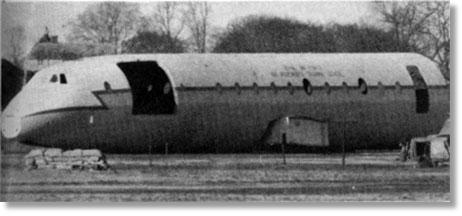
A Britannia fuselage used for Air Movements training. This particular one had been at Brize Norton. Quite a lengthy discussion on it here.
Kit movements run smoothly as Afghanistan drawdown continues
Just a year ago, a tour of the real estate within Camp Bastion set aside to deal with all the stuff that would be rolling in through the camp gates required a good imagination. The guided tour involved peering through fences at huge dusty areas and being told ‘this is where the ISO shipping containers will be going; over there vehicles will be parked before they are brought forward for servicing and maintenance; that’s where they will be bio-washed’. It all seemed, to a civilian who has enormous trouble sorting out a garden shed, a hugely daunting task. But now that redeployment is in full swing, you need no vivid imagination. There it all is, and it’s all working.
There are containers full of properly sorted out kit. Rows of palletised Jackals, and even the body of a Chinook helicopter, are all waiting on the tarmac to start the journey home.
There are containers full of properly sorted out kit. Rows of palletised Jackals, and even the body of a Chinook helicopter, are all waiting on the tarmac to start the journey home.
As base closures and handovers continue in Helmand, the flow of equipment through Camp Bastion and out of Afghanistan is well underway.
The good news for the UK taxpayer is that this is not just the military demonstrating their logistics prowess on a grand scale, but an exercise in accountability, responsibility and value for money.
Lieutenant Colonel Ceri Morton is based in HQ Joint Force Support at Camp Bastion. She is responsible for all the redeployment that takes place within Afghanistan:
"As personnel redeploy, so the kit and the equipment they were using is redeployed in the correct form or status, or it is disposed of properly,” she explained.
“It means that all operational accounts are reconciled and closed and all real estate is either handed over to the legal owners or transferred to Afghan institutions in a responsible way."
The good news for the UK taxpayer is that this is not just the military demonstrating their logistics prowess on a grand scale, but an exercise in accountability, responsibility and value for money.
Lieutenant Colonel Ceri Morton is based in HQ Joint Force Support at Camp Bastion. She is responsible for all the redeployment that takes place within Afghanistan:
"As personnel redeploy, so the kit and the equipment they were using is redeployed in the correct form or status, or it is disposed of properly,” she explained.
“It means that all operational accounts are reconciled and closed and all real estate is either handed over to the legal owners or transferred to Afghan institutions in a responsible way."
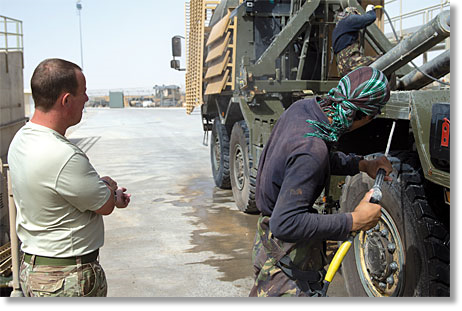
This time last year, the bio-wash, where vehicles are scrupulously pressure-washed to rigorous DEFRA standards, ridding them of any nasties that they may have picked up during their time in the sand, was just a scrape in the ground. Now it’s working, often round the clock, on a 3-shift system. And it needs to, when you consider that it can take 12 hours to thoroughly clean a large container truck, and that by the end of 2014 something like 2,720 vehicles will have gone through the system.
Each step of the process to get kit from the front line back to the UK has been carefully thought through:
"A lot of planning has gone into this, not just the space that’s required, but also the linear design,” said Major Stuart Ferguson, Officer Commanding Reverse Support Chain (RSC) Squadron. “It’s all been designed so that materiel flows in, through and out again smoothly."
Each step of the process to get kit from the front line back to the UK has been carefully thought through:
"A lot of planning has gone into this, not just the space that’s required, but also the linear design,” said Major Stuart Ferguson, Officer Commanding Reverse Support Chain (RSC) Squadron. “It’s all been designed so that materiel flows in, through and out again smoothly."
But we shouldn’t be surprised. After all, the British military have been breaking down bases for centuries, and lessons have been learned from Iraq. Stretched out before us in Bastion is the result. It all seems very logical.
"A pan-defence planning group in the UK created and has overseen all of this,” said Lieutenant Colonel Morton. “It involved detailed planning in theatre too by Joint Force Support and an investment of around $11 million in the reverse supply chain infrastructure to make it happen. We’ve got a load-handling area for when the shipping containers of kit come back in, we have weighbridges, an airside storage facility and a cargo yard all set up deliberately."
This is the first stage of what is a 3-stage process, possibly the biggest logistical challenge in a generation. Stage 1 starts when an operational commander decides that a piece of equipment or a vehicle is surplus to requirements in theatre:
"It’s declared as surplus by the pan-defence planning committee in the UK,” said Lieutenant Colonel Morton. “A subset of that committee then considers whether that item will be needed for future operations.
"No decisions are made about any of this in theatre. If it is needed, the questions then asked are how much will it cost to bring back? What state is it likely to be in? Would it be cheaper to dispose of it? If that’s the answer, we figure out the best way of going about it.
"We re-consume wherever we can. We eat it, fire it, put it in our fuel tanks, use up spares before ordering more."
But the logistics team (loggies) get an extra layer of job satisfaction; because, although redeploying kit might be the main activity, supporting operations is still the main effort. So they have to keep a keen eye on kit movements both in and out of theatre. They must make sure that the troops have all the beans, bullets and bandages they need.
Lieutenant Colonel Morton is professionally relaxed about that. Logistics, she is keen to point out, is a science not an art. So, while no extra kit will be flown into Afghanistan if there is no clear need, stocks will match the capability that is needed on the ground:
"We’ve been in Afghanistan for more than 10 years, so we pretty much know what the demand is here, based on the tasks the units have to perform,” she said. “Our profiles and our systems mean we can track items and identify and manage surpluses pretty effectively."
"A pan-defence planning group in the UK created and has overseen all of this,” said Lieutenant Colonel Morton. “It involved detailed planning in theatre too by Joint Force Support and an investment of around $11 million in the reverse supply chain infrastructure to make it happen. We’ve got a load-handling area for when the shipping containers of kit come back in, we have weighbridges, an airside storage facility and a cargo yard all set up deliberately."
This is the first stage of what is a 3-stage process, possibly the biggest logistical challenge in a generation. Stage 1 starts when an operational commander decides that a piece of equipment or a vehicle is surplus to requirements in theatre:
"It’s declared as surplus by the pan-defence planning committee in the UK,” said Lieutenant Colonel Morton. “A subset of that committee then considers whether that item will be needed for future operations.
"No decisions are made about any of this in theatre. If it is needed, the questions then asked are how much will it cost to bring back? What state is it likely to be in? Would it be cheaper to dispose of it? If that’s the answer, we figure out the best way of going about it.
"We re-consume wherever we can. We eat it, fire it, put it in our fuel tanks, use up spares before ordering more."
But the logistics team (loggies) get an extra layer of job satisfaction; because, although redeploying kit might be the main activity, supporting operations is still the main effort. So they have to keep a keen eye on kit movements both in and out of theatre. They must make sure that the troops have all the beans, bullets and bandages they need.
Lieutenant Colonel Morton is professionally relaxed about that. Logistics, she is keen to point out, is a science not an art. So, while no extra kit will be flown into Afghanistan if there is no clear need, stocks will match the capability that is needed on the ground:
"We’ve been in Afghanistan for more than 10 years, so we pretty much know what the demand is here, based on the tasks the units have to perform,” she said. “Our profiles and our systems mean we can track items and identify and manage surpluses pretty effectively."
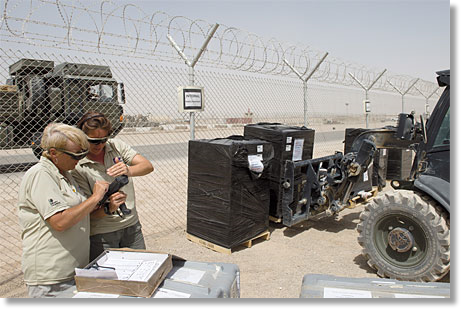
The second stage is moving all the equipment and vehicles out of Afghanistan to their next destination. This activity is owned by the Permanent Joint Headquarters in Northwood. The final stage is what happens to it all when it arrives at the strategic base, its final destination. But this part of the story all begins at the forward bases that are closing down, when everything is given its first sorting through.
"We deploy a specialist logistics team forward to advise the bases. Effectively everything is sorted into piles such as equipment spares, ammunition, and so on,” said Major Ferguson.
"Then they sort it into piles, for example, things that it is really important that we don’t lose track of, what is going to be needed right up to the last minute, and things deemed ‘ACTO’ - attractive to criminals and terrorist organisations. This includes things like batteries and old fire extinguishers which could be used by insurgents to make IEDs (improvised explosive devices)."
"We deploy a specialist logistics team forward to advise the bases. Effectively everything is sorted into piles such as equipment spares, ammunition, and so on,” said Major Ferguson.
"Then they sort it into piles, for example, things that it is really important that we don’t lose track of, what is going to be needed right up to the last minute, and things deemed ‘ACTO’ - attractive to criminals and terrorist organisations. This includes things like batteries and old fire extinguishers which could be used by insurgents to make IEDs (improvised explosive devices)."
Then, in a similar way to which it first arrived, delivered by combat logistic patrols, it all finds its way back to Bastion where further sorting takes place and more experts are on hand to give advice.
Teams of subject matter experts from the depots at Bicester and Donnington and people with expertise in weapons and dangerous goods, such as paints and gases, are on hand to offer advice with the sorting and checking. Major Ferguson said:
"There may be some doubt about a particular item and we can get it from the horse’s mouth - ‘well, if you did send that all the way back to the UK, it would only get disposed of, it wouldn’t go back on the shelf’ - so we can then dispose of it here, saving the cost of transport."
Up to this point the kit is still the responsibility of the unit that owned it. Once the amount and condition of the returned kit has been agreed, it is signed off and is no longer the responsibility of the unit. It is this level of accountability which has helped to avoid the problem that has reared its head in the past, where soldiers, eager to get away, resort to throwing things into a shipping container for the loggies to sort out later. Mick Thorn, one of the reverse support chain experts, said:
"Some of my team have experienced returns from other operations where that’s happened, but this has been conducted entirely differently."
Teams of subject matter experts from the depots at Bicester and Donnington and people with expertise in weapons and dangerous goods, such as paints and gases, are on hand to offer advice with the sorting and checking. Major Ferguson said:
"There may be some doubt about a particular item and we can get it from the horse’s mouth - ‘well, if you did send that all the way back to the UK, it would only get disposed of, it wouldn’t go back on the shelf’ - so we can then dispose of it here, saving the cost of transport."
Up to this point the kit is still the responsibility of the unit that owned it. Once the amount and condition of the returned kit has been agreed, it is signed off and is no longer the responsibility of the unit. It is this level of accountability which has helped to avoid the problem that has reared its head in the past, where soldiers, eager to get away, resort to throwing things into a shipping container for the loggies to sort out later. Mick Thorn, one of the reverse support chain experts, said:
"Some of my team have experienced returns from other operations where that’s happened, but this has been conducted entirely differently."
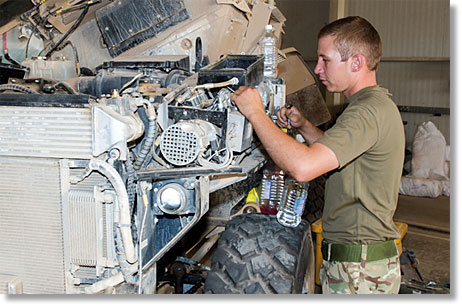
Over at the light engineering workshops of the Theatre Equipment Support Group, the same smooth thinking is being applied to the vehicles leaving theatre. This is the Bastion-based hub of the engineering expertise for servicing and upgrading vehicles in theatre.
During periods of what the troops call normal jogging, vehicles are maintained as far forward as possible. But vehicles that are leaving theatre get their final servicing here:
"We know what’s going to be coming in,” said the officer commanding, Major David Smith. “We know what the next tour [Herrick 19] will need. The bandwidth of our activity is redeployment now. But it doesn’t matter to us; whether we are working on a vehicle that’s going back to the front or going home, we have plenty of experience working on all vehicles across the fleet, so we have nothing to fear."
What matters here, as it does at every stage of redeployment, is maintaining a smooth flow of work.
During periods of what the troops call normal jogging, vehicles are maintained as far forward as possible. But vehicles that are leaving theatre get their final servicing here:
"We know what’s going to be coming in,” said the officer commanding, Major David Smith. “We know what the next tour [Herrick 19] will need. The bandwidth of our activity is redeployment now. But it doesn’t matter to us; whether we are working on a vehicle that’s going back to the front or going home, we have plenty of experience working on all vehicles across the fleet, so we have nothing to fear."
What matters here, as it does at every stage of redeployment, is maintaining a smooth flow of work.
When their tour began, due to the pace of base closures, there was a bow wave of vehicles for the engineers to attend to and bring up to standard:
"We deployed with fewer headcount,” said Major Smith, “but we brought a surge of 230 vehicle mechanics and other trades with us to deal with the backlog of vehicles. We took over 130 vehicles as part of the redeployment. It took us about 6 weeks to deal with the backlog.
"It’s been a real mixture, but what we are working on now is the last wave of Jackals and Coyotes being pushed through by the end of September."
Over at the cargo ready to move yard, Duty Air Movements Officer Flight Lieutenant Chris Ashby is one of the last people to wave all these vehicles and pallets of kit goodbye as they leave theatre:
"We handle up to 10,000 passenger movements a month, so our redeployment has to fit within that,” he said, “which means we have to have a close relationship with the RSC Squadron to supply us with the vehicles and freight leaving theatre."
"We deployed with fewer headcount,” said Major Smith, “but we brought a surge of 230 vehicle mechanics and other trades with us to deal with the backlog of vehicles. We took over 130 vehicles as part of the redeployment. It took us about 6 weeks to deal with the backlog.
"It’s been a real mixture, but what we are working on now is the last wave of Jackals and Coyotes being pushed through by the end of September."
Over at the cargo ready to move yard, Duty Air Movements Officer Flight Lieutenant Chris Ashby is one of the last people to wave all these vehicles and pallets of kit goodbye as they leave theatre:
"We handle up to 10,000 passenger movements a month, so our redeployment has to fit within that,” he said, “which means we have to have a close relationship with the RSC Squadron to supply us with the vehicles and freight leaving theatre."
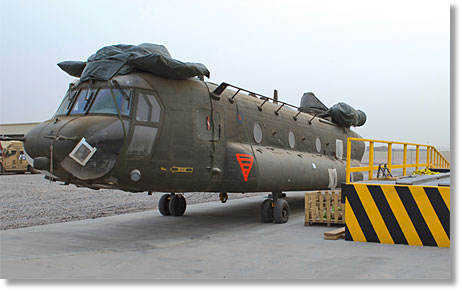
Each C-17 transport aircraft can cope with between 2 and 4 vehicles. Lieutenant Colonel Morton said:
"Working at full tilt we are shifting about 150 vehicles a month. Between the beginning of October 2012 and the end of July this year we’ve done 1,000 vehicles and major pieces of equipment."
Flight Lieutenant Ashby said: "We are moving about 700 pallets of kit a month. Every other day we move a 747’s worth of freight in and out of theatre. We are bringing in things like food and sending out around 80 tonnes, that’s 42 pallets of equipment every 2 days. But we are within our capacity."
To make it all work, hard standing areas have been specially laid down for the freight, and dust-free areas created for the vehicles prepared for redeployment.
"Working at full tilt we are shifting about 150 vehicles a month. Between the beginning of October 2012 and the end of July this year we’ve done 1,000 vehicles and major pieces of equipment."
Flight Lieutenant Ashby said: "We are moving about 700 pallets of kit a month. Every other day we move a 747’s worth of freight in and out of theatre. We are bringing in things like food and sending out around 80 tonnes, that’s 42 pallets of equipment every 2 days. But we are within our capacity."
To make it all work, hard standing areas have been specially laid down for the freight, and dust-free areas created for the vehicles prepared for redeployment.
Flight Lieutenant Ashby said:
"We have space for about 30 vehicles, that’s inbound as well as outbound, so we don’t want anything sitting here for long, nobody wants that."
Up to the end of September a major task was returning the Jackal vehicles, 2-at-a-time on each 747 run. To speed up the preloading process, a bespoke method for palletising and strapping down the vehicles was introduced, satisfying international air transport regulations:
"We also built a ramp so that vehicles up to 10 tonnes in weight can drive up onto a special outsized pallet which can then go straight onto one of our aircraft freight-loading vehicles,” said Flight Lieutenant Ashby.
"We are at the end of a very long line, which is why it’s so important that we keep in close touch with the Joint Force Support people so we get the correct flow and the right balance of kit and vehicles flowing through."
Lieutenant Colonel Morton may have overall responsibility for co-ordinating all this, but, as she is keen to point out, redeployment on this scale is a team sport. She said:
"It’s the responsibility of every unit in theatre and every deployed command."
But from the evidence on the ground, it looks like everyone in that very long line has responded to that challenge and are keen to be seen as smooth operators.
MoD
"We have space for about 30 vehicles, that’s inbound as well as outbound, so we don’t want anything sitting here for long, nobody wants that."
Up to the end of September a major task was returning the Jackal vehicles, 2-at-a-time on each 747 run. To speed up the preloading process, a bespoke method for palletising and strapping down the vehicles was introduced, satisfying international air transport regulations:
"We also built a ramp so that vehicles up to 10 tonnes in weight can drive up onto a special outsized pallet which can then go straight onto one of our aircraft freight-loading vehicles,” said Flight Lieutenant Ashby.
"We are at the end of a very long line, which is why it’s so important that we keep in close touch with the Joint Force Support people so we get the correct flow and the right balance of kit and vehicles flowing through."
Lieutenant Colonel Morton may have overall responsibility for co-ordinating all this, but, as she is keen to point out, redeployment on this scale is a team sport. She said:
"It’s the responsibility of every unit in theatre and every deployed command."
But from the evidence on the ground, it looks like everyone in that very long line has responded to that challenge and are keen to be seen as smooth operators.
MoD
New members who have joined us recently:
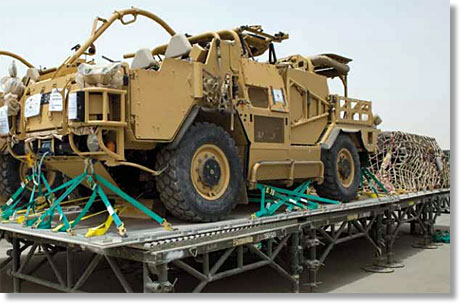

RAF
Jack Grattan, Duras, France
Bill Glew, London W4, United Kingdom
Bill Glew, London W4, United Kingdom
Jack Jones, Carterton, Oxon, United Kingdom
Welcome to the OBA!
From: Nick Price, Cheltenham
Sent: Friday, October 04, 2013 1:28 PM
Subject: Facebook Gems
Hi Tony,
Picked up this photo on RAF Hereford Facebook.
Third guy on right is Adi Tew believed to be now a Flt/Sgt on MAMS.
Thought it would be quite amusing to embarrass him, if indeed after a little investigation it turns out to be true!
Nick
Sent: Friday, October 04, 2013 1:28 PM
Subject: Facebook Gems
Hi Tony,
Picked up this photo on RAF Hereford Facebook.
Third guy on right is Adi Tew believed to be now a Flt/Sgt on MAMS.
Thought it would be quite amusing to embarrass him, if indeed after a little investigation it turns out to be true!
Nick
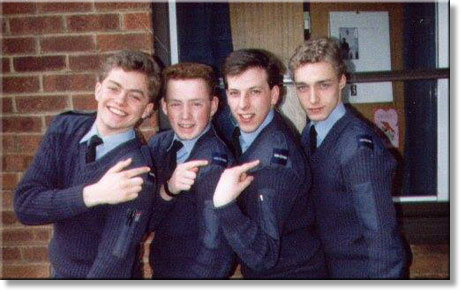
From: OBie O'Brien, Corinda, QLD
Date: 9/15/2013, 8:25 pm, EDT
Subject: Update
G'Day all!
Update time: just after getting home from Djib in Jan this year, the mob I previously worked for, facilitating UN Peacekeeping activities and deployments, decided early Feb that they could dispense with my services, with an hour's notice to vacate the building - according to my release document it was nothing to do with my work performance but all to do with a downturn in the economy, which it would appear, none of their bright young business development whips saw coming!
So a bunch of productive, operations specialists get the boot, and the support hangers-on get kept - still can't work that out. Anyway, as they said in the classic, "I'm free ... ", and quite frankly, enjoying the late get-ups and doing some volunteer work whilst waiting for the hordes of prospective employers to come a'knockin'! New email and mobile as indicated in the nominal roll page.
Cop yers all, and keep on truckin' ...
Regards, OBie
Date: 9/15/2013, 8:25 pm, EDT
Subject: Update
G'Day all!
Update time: just after getting home from Djib in Jan this year, the mob I previously worked for, facilitating UN Peacekeeping activities and deployments, decided early Feb that they could dispense with my services, with an hour's notice to vacate the building - according to my release document it was nothing to do with my work performance but all to do with a downturn in the economy, which it would appear, none of their bright young business development whips saw coming!
So a bunch of productive, operations specialists get the boot, and the support hangers-on get kept - still can't work that out. Anyway, as they said in the classic, "I'm free ... ", and quite frankly, enjoying the late get-ups and doing some volunteer work whilst waiting for the hordes of prospective employers to come a'knockin'! New email and mobile as indicated in the nominal roll page.
Cop yers all, and keep on truckin' ...
Regards, OBie
From: Taff Farrow, Stafford
Date: 10/7/2013, 8:39 am, EDT
Subject: Fat Alberts
Date: 10/7/2013, 8:39 am, EDT
Subject: Fat Alberts
Greetings to all Movers past and present from all the Movers up in Stafford.
The "Fat Albert graveyard" (Hixon) gives a very strange feeling when passing them on the disused runway there!
Life goes on though eh! Herc and the VC 10 of course with its back breaking TPU's going on and off!
Best to all!
Taff
The "Fat Albert graveyard" (Hixon) gives a very strange feeling when passing them on the disused runway there!
Life goes on though eh! Herc and the VC 10 of course with its back breaking TPU's going on and off!
Best to all!
Taff
From: Wayne Laidlaw, Loja, Andalusia
Sent: Monday, October 07, 2013 3:04 PM
Subject: Memorabilia
Tony,
Whilst with NEAF MAMS I was involved with the last days of RAF Idris, Libya. I have been going through my old stuff and have found an RAF Idris Xmas card in virgin condition (never handled or used).
If any member would like it for his/her collection, I would be happy to send it to them. It is badged RAF Idris.
All the best
Wayne
Sent: Monday, October 07, 2013 3:04 PM
Subject: Memorabilia
Tony,
Whilst with NEAF MAMS I was involved with the last days of RAF Idris, Libya. I have been going through my old stuff and have found an RAF Idris Xmas card in virgin condition (never handled or used).
If any member would like it for his/her collection, I would be happy to send it to them. It is badged RAF Idris.
All the best
Wayne
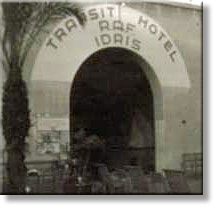
From: Andrew Kay, Colorado Springs, CO
Sent: Monday, October 07, 2013 4:52 PM
Subject: Pension follow up
Hi Tony,
I thought I would follow up on something I sent you a year or so back looking for advice on my RAF pension as I thought my experiences might be useful for those that may be in the same position as me and looking to get pensions paid to them when they live outside the UK.
I completed all of my paperwork with the Service Personnel and Veterans Agency (SPVA) and they then put me in contact with Xafinity, who are apparently the civilian company that handles all of the payments side on behalf of the services. All of this was done by mail and as a result the time lag was considerable as everything had to go back and forth a few times. I waited like an expectant father expecting to see my terminal lump sum appear in my bank account around my 60th birthday.... but nothing. So I called them and it seemed that my bank details had never reached them and that a check (cheque?) for the lump sum was somewhere between Sussex and Colorado. When it arrived I took it to my bank only to be told it would take 4-6 weeks for it to clear. Oh well. I called Xafinity back (bear in mind I have to call them in the early hours of the morning as I am 7 hours behind the UK) to let them know the check had arrived as they had asked me to do.
About four weeks later I hadn't heard anything so I called my bank only to get the news that the check had a stop payment order on it and it was being returned to me. Not good. Another call to the UK and I was told they stopped the check because they thought I had called to say it hadn't arrived (not to let them know I got it). The young lady said "It's OK sir, there's another check on its way to you". I told her they can take a long time to clear through the banking system so she kindly offered to put a stop order on that one and start the ball rolling on getting the money deposited directly to my account (as they now have my bank information). Well within 10 days it was paid in and it looks like the monthly payment will be going in on time every month.
So if you are in a similar spot, I would advise being patient and eventually it will work out. I do have to say though that every time I called Xafinity, they were extremely helpful and very polite so I only have good things to say about them.
Now of course in 5 years time I have go through the same procedure to try and get my state pension out of HMG!.
all the best,
Andy
Sent: Monday, October 07, 2013 4:52 PM
Subject: Pension follow up
Hi Tony,
I thought I would follow up on something I sent you a year or so back looking for advice on my RAF pension as I thought my experiences might be useful for those that may be in the same position as me and looking to get pensions paid to them when they live outside the UK.
I completed all of my paperwork with the Service Personnel and Veterans Agency (SPVA) and they then put me in contact with Xafinity, who are apparently the civilian company that handles all of the payments side on behalf of the services. All of this was done by mail and as a result the time lag was considerable as everything had to go back and forth a few times. I waited like an expectant father expecting to see my terminal lump sum appear in my bank account around my 60th birthday.... but nothing. So I called them and it seemed that my bank details had never reached them and that a check (cheque?) for the lump sum was somewhere between Sussex and Colorado. When it arrived I took it to my bank only to be told it would take 4-6 weeks for it to clear. Oh well. I called Xafinity back (bear in mind I have to call them in the early hours of the morning as I am 7 hours behind the UK) to let them know the check had arrived as they had asked me to do.
About four weeks later I hadn't heard anything so I called my bank only to get the news that the check had a stop payment order on it and it was being returned to me. Not good. Another call to the UK and I was told they stopped the check because they thought I had called to say it hadn't arrived (not to let them know I got it). The young lady said "It's OK sir, there's another check on its way to you". I told her they can take a long time to clear through the banking system so she kindly offered to put a stop order on that one and start the ball rolling on getting the money deposited directly to my account (as they now have my bank information). Well within 10 days it was paid in and it looks like the monthly payment will be going in on time every month.
So if you are in a similar spot, I would advise being patient and eventually it will work out. I do have to say though that every time I called Xafinity, they were extremely helpful and very polite so I only have good things to say about them.
Now of course in 5 years time I have go through the same procedure to try and get my state pension out of HMG!.
all the best,
Andy
Medals presented at Ohakea Air Movements Section
On 7 July a medal presentation took place at the Ohakea Air Movements Section.
Flight sergeant Graham Ellis was presented with his Long Service and Good Conduct Clasp and SGT Gideon Wych with his Timor Leste Solidarity Medal, by the CO, Expeditionary Support Squadron (ESS), WGCDR Harvey. As it was a ‘less formal’ presentation (with CAF’s special approval) and held locally, it allowed for F/S Ellis's wife (Bell), and his mother to attend, along with a small group of other ESS personnel.
Flight sergeant Graham Ellis was presented with his Long Service and Good Conduct Clasp and SGT Gideon Wych with his Timor Leste Solidarity Medal, by the CO, Expeditionary Support Squadron (ESS), WGCDR Harvey. As it was a ‘less formal’ presentation (with CAF’s special approval) and held locally, it allowed for F/S Ellis's wife (Bell), and his mother to attend, along with a small group of other ESS personnel.
The Timor-Leste Solidarity Medal was presented to SGT Gideon Wych.
The Timor-Leste Solidarity Medal is a State Decoration of Timor-Leste which is awarded to National and International forces who have contributed to stability and peace operations in Timor-Leste since 1 May 2006.
The approving authority for the awarding of this medal is the President of the Republic of Timor-Leste.
In 2006, as a member of the NZ Army, SGT Wych was posted to Timor Leste. His subsequent Service change delayed the presentation of this medal, which was presented by WGCDR Harvey.
airforce.mil.nz
The Timor-Leste Solidarity Medal is a State Decoration of Timor-Leste which is awarded to National and International forces who have contributed to stability and peace operations in Timor-Leste since 1 May 2006.
The approving authority for the awarding of this medal is the President of the Republic of Timor-Leste.
In 2006, as a member of the NZ Army, SGT Wych was posted to Timor Leste. His subsequent Service change delayed the presentation of this medal, which was presented by WGCDR Harvey.
airforce.mil.nz
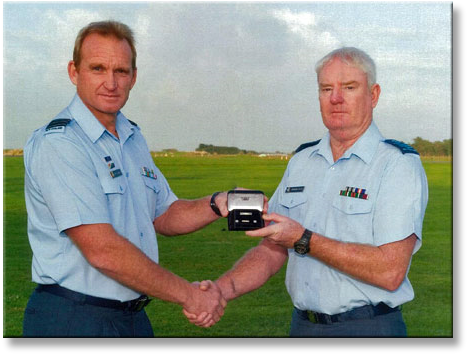
F/S Graham Ellis was presented with his Clasp to the Long Service & Good Conduct Medal, with effect 19 June 2010.
F/S Ellis joined the RNZAF as an Airman Cadet in January 1977, and following on from his successful completion of his trade training, he has served at a myriad of Defence locations, including RNZAF Base's Wigram, Woodbourne, Auckland & Ohakea and Support Branch in Wellington. Promotion to Corporal occurred in 1980, followed by promotion to Sergeant in March 1985. A highlight of F/S Ellis's career occurred in 1986 when he was posted to the New Zealand Ordnance Depot in Singapore, where he met his wife, Marabell (Bell).
He was promoted to Flight Sergeant in April 1992 at Base Ohakea; that June F/S Ellis was awarded the New Zealand Long Service & Good Conduct medal. In November 2001, F/S Ellis was promoted to the rank of Warrant Officer.
Graham left the RNZAF in 2002 after 25 years service to the RNZAF, but he later re-enlisted in 2005 in the rank of Sergeant and was subsequently promoted back to Flight Sergeant in 2007.
F/S Ellis joined the RNZAF as an Airman Cadet in January 1977, and following on from his successful completion of his trade training, he has served at a myriad of Defence locations, including RNZAF Base's Wigram, Woodbourne, Auckland & Ohakea and Support Branch in Wellington. Promotion to Corporal occurred in 1980, followed by promotion to Sergeant in March 1985. A highlight of F/S Ellis's career occurred in 1986 when he was posted to the New Zealand Ordnance Depot in Singapore, where he met his wife, Marabell (Bell).
He was promoted to Flight Sergeant in April 1992 at Base Ohakea; that June F/S Ellis was awarded the New Zealand Long Service & Good Conduct medal. In November 2001, F/S Ellis was promoted to the rank of Warrant Officer.
Graham left the RNZAF in 2002 after 25 years service to the RNZAF, but he later re-enlisted in 2005 in the rank of Sergeant and was subsequently promoted back to Flight Sergeant in 2007.
Since his return to the RNZAF, F/S Ellis has been employed as a part of No.209 (Expeditionary Support) Squadron, as the SNCOIC of the Ohakea Air Movements Section. He plays a pivotal role in maintaining professional standards as well as a leading role in the development of his subordinates.
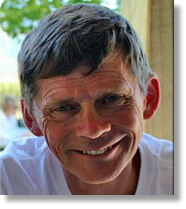
THE UNSUNG ACHIEVERS
by Captain Chip Henriss-Anderssen - November 18, 1997
Among the muffled shouts of RAAF C-130 and Caribou crew whose voices are drowned out by the roar of aircraft engines at Jackson's Airfield in Port Moresby are a group of people who, although small in number, and not considered as glamorous as others in business of aviation, stand out as the real movement force in Operation Sierra.
Operation Sierra is the Australian Defence Force component to the Drought Relief Operation in Papua New Guinea.
The work force behind Op Sierra is a group of six people from the RAAF¹s Mobile Air Terminal Unit (MATU) and their counterparts from the PNG Defence Force.
Together they are responsible for; ordering food aid, unloading trucks, keeping tallies on all stock, building loads for the aircraft and producing weight and balance paperwork for the crew. They are also in the business of coordinating all passenger and cargo requests.
Operation Sierra is the Australian Defence Force component to the Drought Relief Operation in Papua New Guinea.
The work force behind Op Sierra is a group of six people from the RAAF¹s Mobile Air Terminal Unit (MATU) and their counterparts from the PNG Defence Force.
Together they are responsible for; ordering food aid, unloading trucks, keeping tallies on all stock, building loads for the aircraft and producing weight and balance paperwork for the crew. They are also in the business of coordinating all passenger and cargo requests.
By the end of this month the unit will have moved more than 612 tonnes of rice. Without MATU nothing in Operation Sierra would move. And controlling all this is one woman who can be found working at all hours that areoplanes fly. Flight Lieutenant Kirrily Dearing has helped move people and cargo and just about anything else you can fit on an aircraft for the last seven years.
She began her career at the Australian Defence Force Academy (ADFA) in her home town of Canberra after completing year 12 at Phillip College.
"I guess my grandfathers had a bit to do with me choosing a military career. They both served in Papua New Guinea during World War II and that did have an influence on me," FLT LT Dearing said.
At ADFA and during her training after graduation she learned skills which are an important feature of any military unit, teamwork and discipline.
She began her career at the Australian Defence Force Academy (ADFA) in her home town of Canberra after completing year 12 at Phillip College.
"I guess my grandfathers had a bit to do with me choosing a military career. They both served in Papua New Guinea during World War II and that did have an influence on me," FLT LT Dearing said.
At ADFA and during her training after graduation she learned skills which are an important feature of any military unit, teamwork and discipline.
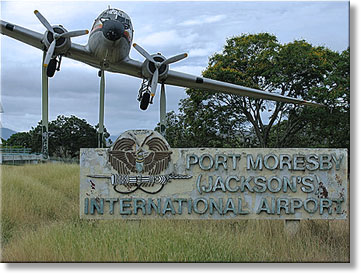
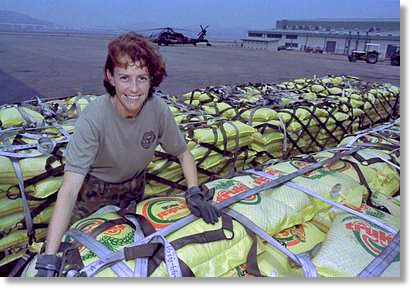
"We're a very tight unit. I have six guys working for me and we all know each others strengths and weaknesses. There's really no room for anyone of us not to pull their weight," she said.
FLT LT Dearing is responsible for everything that gets put onto an Australian aircraft and can often be found strapping down loads with her crew or arranging flights for visiting journalists over the telephone.
FLT LT Dearing is responsible for everything that gets put onto an Australian aircraft and can often be found strapping down loads with her crew or arranging flights for visiting journalists over the telephone.
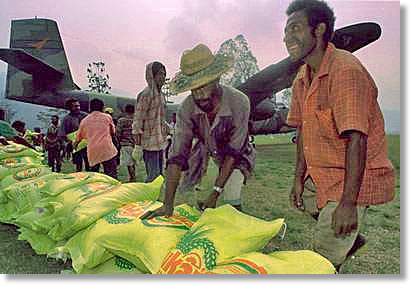
She and her personnel have also developed a close relationship with the PNG Defence Force members who work with them.
"The PNGDF guys we have with us are really doing well. They're used to working in a different environment to us and it's been fun showing them the way we do things and seeing how they do things as well," she said.
MATU personnel usually don't get to see their cargo being off loaded to hungry villagers in the remote communities of PNG but they do hear reports and feel their work is worthwhile.
"It is good to know that what we do is being appreciated. It's also satisfying to be taking part in a real-time operation where all the skills we've developed during training are put into practice," she said.
"The PNGDF guys we have with us are really doing well. They're used to working in a different environment to us and it's been fun showing them the way we do things and seeing how they do things as well," she said.
MATU personnel usually don't get to see their cargo being off loaded to hungry villagers in the remote communities of PNG but they do hear reports and feel their work is worthwhile.
"It is good to know that what we do is being appreciated. It's also satisfying to be taking part in a real-time operation where all the skills we've developed during training are put into practice," she said.
As to her future, "I like the hands-on part of this job. I did think about swapping over to become a pilot during my last year at ADFA but I'm very happy here. If I decide to leave the RAAF I'd probably move into something like outdoor education. I just can't see myself stuck behind a desk."
(Update, October 2013: Wing Commander Dearing is currently OC 1 Airfield Operational Support Squadron, RAAF Darwin, NT)
From: Ian Berry, West Swindon
Sent: Thursday, October 17, 2013 6:17 AM
Subject: RAF Mystery Photo 092713
Hi Tony,
The two at the back I recognize - Left/Right Pete Johnston and my dear old mate Dave Cromb.
Some others I recognsie but cannot accurately name.
Where? Well.... Dave served at Akrotiri and Masirah and as he looks younger than the Gulf days I would say Akrotiri in the late 60s...
Ian
Sent: Thursday, October 17, 2013 6:17 AM
Subject: RAF Mystery Photo 092713
Hi Tony,
The two at the back I recognize - Left/Right Pete Johnston and my dear old mate Dave Cromb.
Some others I recognsie but cannot accurately name.
Where? Well.... Dave served at Akrotiri and Masirah and as he looks younger than the Gulf days I would say Akrotiri in the late 60s...
Ian
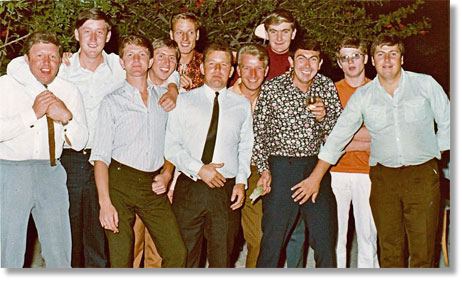
RCAF Provides Airlift Support to the UN and OPCW
At the request of the United Nations (UN), Canada provided military airlift this week to support the Organisation for the Prohibition of Chemical Weapons (OPCW), whose members are presently operating in Syria.
The Canadian Armed Forces (CAF) contributed a Royal Canadian Air Force (RCAF) CC-177 Globemaster III aircraft from 8 Wing Trenton, Ontario, to deliver 10 armoured civilian vehicles to the OPCW. These vehicles, donated by the United States (U.S.), will be used by the OPCW to safely transport their members, along with UN personnel involved in verifying and destroying Syria's chemical weapons.
"Canada is committed to assisting the UN and the OPCW in their efforts to ensure the elimination of chemical weapons in Syria," said the Honourable Rob Nicholson, Minister of National Defence. "This airlift mission by the RCAF is just another fine example of the capability of the CAF and their readiness to respond rapidly whenever called upon."
The Canadian Armed Forces (CAF) contributed a Royal Canadian Air Force (RCAF) CC-177 Globemaster III aircraft from 8 Wing Trenton, Ontario, to deliver 10 armoured civilian vehicles to the OPCW. These vehicles, donated by the United States (U.S.), will be used by the OPCW to safely transport their members, along with UN personnel involved in verifying and destroying Syria's chemical weapons.
"Canada is committed to assisting the UN and the OPCW in their efforts to ensure the elimination of chemical weapons in Syria," said the Honourable Rob Nicholson, Minister of National Defence. "This airlift mission by the RCAF is just another fine example of the capability of the CAF and their readiness to respond rapidly whenever called upon."
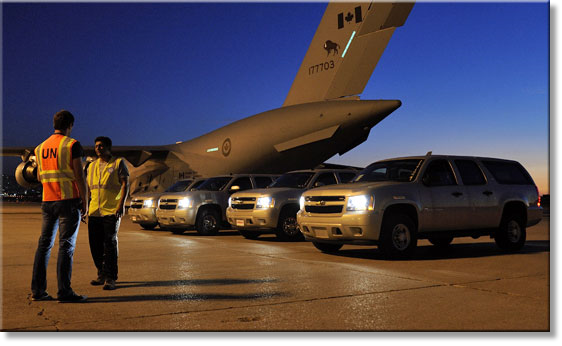
The 10 armoured civilian vehicles were airlifted from Joint Base Andrews, Maryland, U.S. to Lebanon. The vehicles were transported via two flights over a three-day period, starting last Thursday. Another agency is now responsible for moving the vehicles from Lebanon to Syria to assist the work of the OPCW and UN. This aircraft and CAF personnel were not part of any operations in Syria.
Canada's four CC-177 Globemaster III strategic airlifters have been serving Canadians at home and abroad since 2007. As a state-of-the-art strategic airlifter, the Globemaster is able to rapidly transport everything from troops and cargo to oversized combat equipment over intercontinental distances.
DND/CF
Canada's four CC-177 Globemaster III strategic airlifters have been serving Canadians at home and abroad since 2007. As a state-of-the-art strategic airlifter, the Globemaster is able to rapidly transport everything from troops and cargo to oversized combat equipment over intercontinental distances.
DND/CF

Voyagers take lead after VC10s bow out at Brize
The RCAF Regains More of its Past
While the familiar sights and sounds of VC10 tanker planes disappeared from the skies of West Oxfordshire with their retirement last month, a new generation of RAF aircraft is making its mark.
The replacement Voyager tanker and transport planes have stepped into the gap, with six of the eventual 14-strong fleet now available to the RAF. The first of the air station’s new Airbus A400M Atlas transport planes is about to take shape in Spain after its wings arrived in Seville from the UK.
Problems with in-flight refuelling of Typhoon and Tornado strike jets during Voyager testing have been overcome. Almost 1,000 tonnes of fuel have been transferred from Voyagers to Typhoons in mid-air since August. More than 1,300 tonnes have been pumped into the tanks of Tornadoes in mid-air since June.
Phil Blundell, the chief executive of AirTanker, which employs 500 civilian staff and military personnel at Brize Norton, said the Voyager programme was now making “very real progress”. It is due to be fully operational by May next year, allowing the withdrawal of Lockheed Tristar tankers, converted from airliners built in the early 1970s.
Mr Blundell added: “Release to service with the Typhoon represented an important step forward for Voyager, clearing the fast jet programme. Our service and the infrastructure is now there, while six of the aircraft that make up the core nine-strong Voyager fleet have been delivered. We have a very tangible capability.”
The RAF will have first call on the five other Voyagers but they will be available to other operators if not needed for military duties. The planes, converted from Airbus A300-200 airliners, can carry up to 291 passengers or more than 40 tonnes of cargo, as well as 111 tonnes of fuel.
They will be joined at Brize Norton next year by the first of the RAF’s order for 22 Atlas turboprop transport aircraft, to replace the Hercules fleet. The Atlas’s wings were transported by ship from Airbus’s plant near Bristol, to the company’s aircraft plant in Seville this month, arriving days after the first of the planes off the production line was delivered to the French Air Force. A prototype A400M recently came through tough tests on a gravel runway at Ablitas in Spain, with minimal damage from stones.
Brize Norton is already preparing for the Atlas’s arrival, with air loadmasters from XXIV Squadron travelling to Seville for a nine-week course at Airbus Military’s training centre, while RAF technicians are working at the French plane’s base near Orleans. A new building has gone up at Brize Norton to house an Atlas flight simulator and the first Atlas aircrew will join XXIV Squadron at the base this month.
Witney Gazette
Problems with in-flight refuelling of Typhoon and Tornado strike jets during Voyager testing have been overcome. Almost 1,000 tonnes of fuel have been transferred from Voyagers to Typhoons in mid-air since August. More than 1,300 tonnes have been pumped into the tanks of Tornadoes in mid-air since June.
Phil Blundell, the chief executive of AirTanker, which employs 500 civilian staff and military personnel at Brize Norton, said the Voyager programme was now making “very real progress”. It is due to be fully operational by May next year, allowing the withdrawal of Lockheed Tristar tankers, converted from airliners built in the early 1970s.
Mr Blundell added: “Release to service with the Typhoon represented an important step forward for Voyager, clearing the fast jet programme. Our service and the infrastructure is now there, while six of the aircraft that make up the core nine-strong Voyager fleet have been delivered. We have a very tangible capability.”
The RAF will have first call on the five other Voyagers but they will be available to other operators if not needed for military duties. The planes, converted from Airbus A300-200 airliners, can carry up to 291 passengers or more than 40 tonnes of cargo, as well as 111 tonnes of fuel.
They will be joined at Brize Norton next year by the first of the RAF’s order for 22 Atlas turboprop transport aircraft, to replace the Hercules fleet. The Atlas’s wings were transported by ship from Airbus’s plant near Bristol, to the company’s aircraft plant in Seville this month, arriving days after the first of the planes off the production line was delivered to the French Air Force. A prototype A400M recently came through tough tests on a gravel runway at Ablitas in Spain, with minimal damage from stones.
Brize Norton is already preparing for the Atlas’s arrival, with air loadmasters from XXIV Squadron travelling to Seville for a nine-week course at Airbus Military’s training centre, while RAF technicians are working at the French plane’s base near Orleans. A new building has gone up at Brize Norton to house an Atlas flight simulator and the first Atlas aircrew will join XXIV Squadron at the base this month.
Witney Gazette
Five service schoolgirls form Poppy Girls appeal
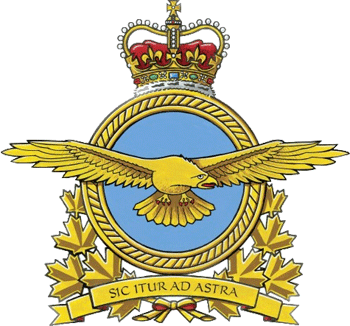
September 30, 2013: The Royal Canadian Air Force has, after 45 years, got its badge back. For over 4 decades the air force was forced to use a rather bland badge to identify itself as the air command. In 2011 the Canadian government reversed a 43 year old decision and restored the “Royal” prefix for the air force and navy. Actually, the decision eliminated the old names (“land forces command,” “air command,” and “maritime command”) and brought back the more traditional Canadian Army, Royal Canadian Air Force, and Royal Canadian Navy. The army does not get a “royal” prefix because while the air force and navy are historically answerable to the crown, the army answers to parliament. Everyone answers to parliament these days, but historical touches like this are popular.
While the opposition in Canada (the New Democratic Party) protested the change, the 1960s unification of the armed forces was widely unpopular, especially within the military. Ultimately it was seen as a scheme that did achieve some efficiency but also allowed politicians to loot the military pension systems for other pet projects. For most Canadians, especially veterans and their families, the loss of the historical names was particularly painful. Subsequent governments have gradually reversed the Euro-style social engineering imposed on the military in the 1960s.
While the opposition in Canada (the New Democratic Party) protested the change, the 1960s unification of the armed forces was widely unpopular, especially within the military. Ultimately it was seen as a scheme that did achieve some efficiency but also allowed politicians to loot the military pension systems for other pet projects. For most Canadians, especially veterans and their families, the loss of the historical names was particularly painful. Subsequent governments have gradually reversed the Euro-style social engineering imposed on the military in the 1960s.
This reversal was essential for the Canadian military to be ready for all the real wars and dangerous humanitarian missions they were sent off to deal with.
Some say the 2011 visit of Prince William and his new wife was the trigger for the name change. But, in fact, the visit was just something of a final push for something that was long in demand. Opinion polls showed that most Canadians accepted the change. While Canadian politics lean more to the left than in the United States, the respect for the British royalty (the queen is still the head-of-state in Canada) has never declined.
Moreover, the 1968 decision did not remove the “royal” prefix from many smaller units, if only because those outfits had some very devoted veterans and fans, who knew how to start a media storm if something they held dear was threatened. So the Princess Patricia's Canadian Light Infantry, the Royal Canadian Regiment, the Royal New Brunswick Regiment, the Royal Newfoundland Regiment, the Royal 22nd Regiment, and the Royal Regina Rifles all remained proudly “royal”. And for the next 4 decades, the fight continued to bring back the Canadian Army, Royal Canadian Air Force, and Royal Canadian Navy. Despite continuing budget cuts, Canadian military personnel feel they have a bit more respect than they have been receiving over the last few decades.
Strategy Page
Some say the 2011 visit of Prince William and his new wife was the trigger for the name change. But, in fact, the visit was just something of a final push for something that was long in demand. Opinion polls showed that most Canadians accepted the change. While Canadian politics lean more to the left than in the United States, the respect for the British royalty (the queen is still the head-of-state in Canada) has never declined.
Moreover, the 1968 decision did not remove the “royal” prefix from many smaller units, if only because those outfits had some very devoted veterans and fans, who knew how to start a media storm if something they held dear was threatened. So the Princess Patricia's Canadian Light Infantry, the Royal Canadian Regiment, the Royal New Brunswick Regiment, the Royal Newfoundland Regiment, the Royal 22nd Regiment, and the Royal Regina Rifles all remained proudly “royal”. And for the next 4 decades, the fight continued to bring back the Canadian Army, Royal Canadian Air Force, and Royal Canadian Navy. Despite continuing budget cuts, Canadian military personnel feel they have a bit more respect than they have been receiving over the last few decades.
Strategy Page
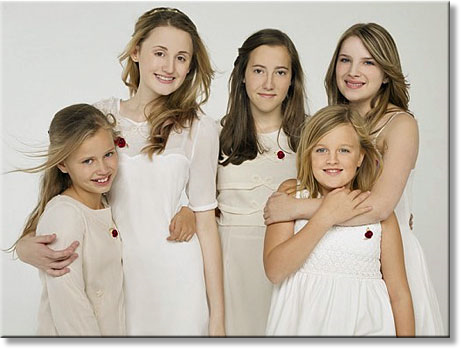
Five schoolgirls with fathers serving in the military have joined up to record this year’s fundraising song for the Royal British Legion’s Poppy Appeal.
The Poppy Girls, aged from 10 to 17, were recruited following a search among forces families by the charity, along with executives from Decca Records.
They were selected following online auditions by more than 1,000 candidates, before a series of studio recordings to whittle down the final shortlist.
The group, Megan Adams, Florence Ransom, Alice Milburn, Bethany Davy and Charlotte Mellor - whose fathers serve in either the Royal Navy, Army or Royal Air Force - have recorded the single, “The Call (no need to say goodbye)”, which will be released on Remembrance Sunday, November 10.
The night before, they will perform in front of the Queen at the Festival of Remembrance, in the Royal Albert Hall. The event will be broadcast on BBC ONE, and is expected to have an audience of six million people.
Telegraph
The Poppy Girls, aged from 10 to 17, were recruited following a search among forces families by the charity, along with executives from Decca Records.
They were selected following online auditions by more than 1,000 candidates, before a series of studio recordings to whittle down the final shortlist.
The group, Megan Adams, Florence Ransom, Alice Milburn, Bethany Davy and Charlotte Mellor - whose fathers serve in either the Royal Navy, Army or Royal Air Force - have recorded the single, “The Call (no need to say goodbye)”, which will be released on Remembrance Sunday, November 10.
The night before, they will perform in front of the Queen at the Festival of Remembrance, in the Royal Albert Hall. The event will be broadcast on BBC ONE, and is expected to have an audience of six million people.
Telegraph
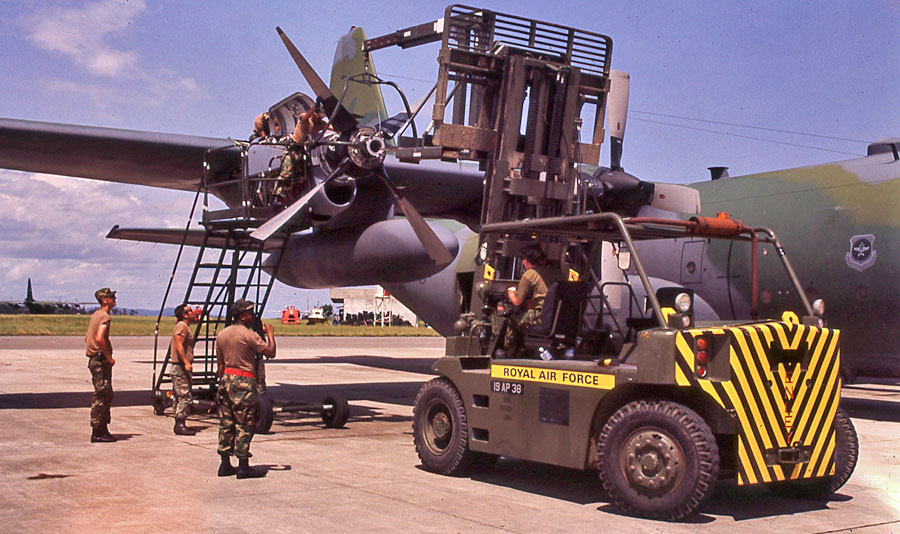
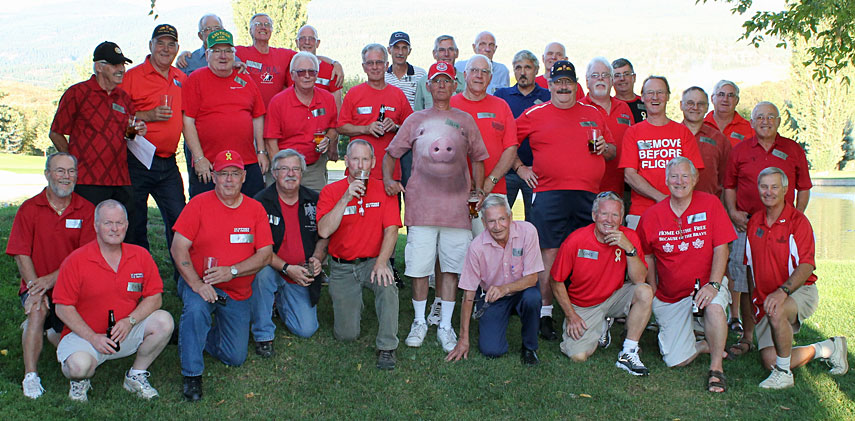
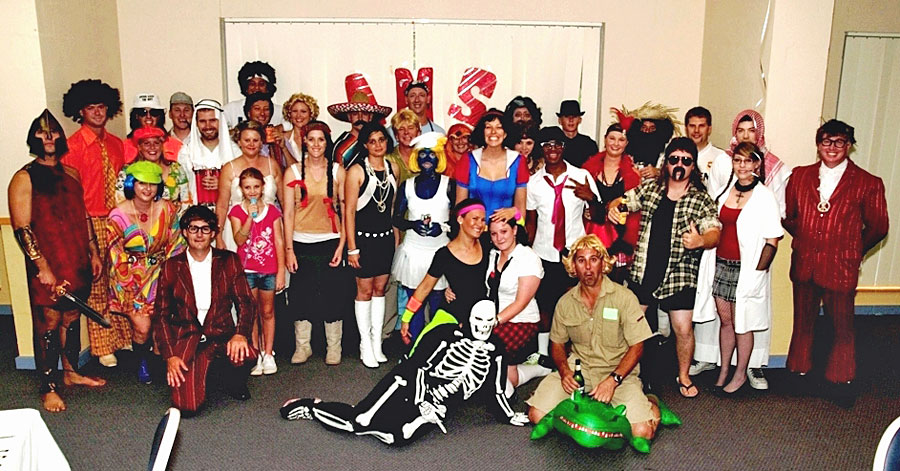
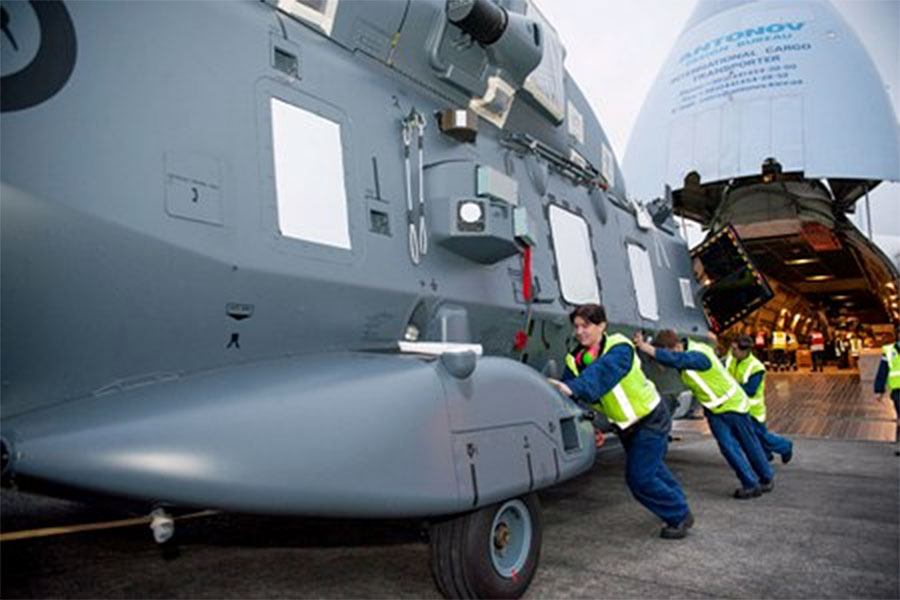
That's it for this edition
Have a great weekend!
Tony
ukmamsoba@gmail.com
Have a great weekend!
Tony
ukmamsoba@gmail.com















